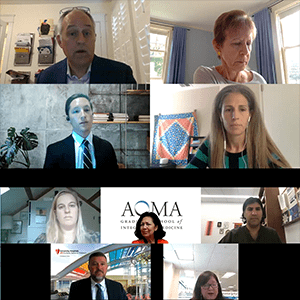 A summary of AACIPM’s September symposium
A summary of AACIPM’s September symposium
During AACIPM’s fall symposium, Equity in Access to Comprehensive Integrative Pain Management for People with Chronic Pain, the agenda included many important leaders who are striving to align coverage policy, network design, and stakeholder communication with evidence-based pain care.
The first session included Kirk Williamson, MPH, Health Policy Analyst, National Governors Association and primary author of their August 2020 report, “Expanding Access to Non-Opioid Management of Chronic Pain: Consideration for Governors”; Nicole Hemmenway, CEO, U.S. Pain Foundation, who reported the findings from their August survey of almost 1600 people living with pain; David Elton, Chief Strategy Officer, United Health Ventures, who demystified some complex big data analyzing access and utilization of non-prescribing providers of pain management by zip code; and Matt Salo, Executive Director, National Association of Medicaid Directors, who provided an overview of current trends and priorities for state Medicaid program leadership across the country.
Then Cindy Steinberg, National Policy and Advocacy Director, U.S. Pain Foundation moderated an interactive discussion with the first session presenters to ask about where the rubber meets the road – how do we promote increased access to people who are underserved for the care that patients want, is often not covered, and when covered, is often still grossly underutilized and inaccessible based on important barriers?
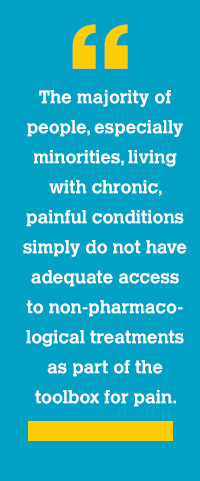 As COVID-19 has made abundantly clear, inequities exist within the U.S. healthcare system. The virus struck particularly hard in communities of color, highlighting numerous barriers to care.
As COVID-19 has made abundantly clear, inequities exist within the U.S. healthcare system. The virus struck particularly hard in communities of color, highlighting numerous barriers to care.
This has serious consequences for the nation’s fight against the opioid misuse and overdose epidemic, given that opiate medications are often the default prescription for chronic pain. It has been widely shown that utilization of alternatives to opioids can save money by reducing the need for other more expensive interventions, including emergency department and inpatient services, costly imaging such as MRIs, surgeries, lab services, and injectable drugs.
Despite the widespread guidance in favor of non-opioid and non-pharmacological treatments, people with pain often find themselves unable to receive this optimal care. In fact, Nicole Hemmenway emphasized recent findings such as more than 75% of US Pain Foundation survey respondents said that cost prevented them from accessing one or more treatment options, with over half of those covered by insurance citing high copays, and two thirds citing insurance limits such as prior authorization and annual caps on treatment. Further, respondents shared that cost is most often a barrier to massage therapy, acupuncture, and chiropractic care—treatments that have been accepted by the Department of Defense and the Veterans Health Administration as effective treatments for chronic pain for many years. These therapies are also covered by Medicare and Medicare Advantage plans.
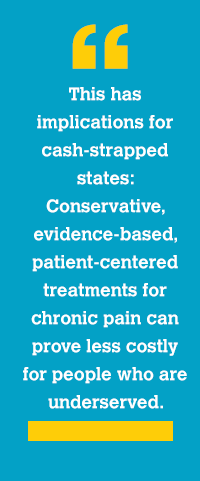
David Elton, a part of the UnitedHealth Group, our country’s largest commercial payor, shared trends from their “big data” which clearly shows that earlier access to conservative non-pharmacological therapies for people with pain improves outcomes, lowers costs, and avoids surgeries and ER visits. Using data analysis based on zip codes, Dr. Elton presented a map which illustrated about 2 million episodes of back pain at a zip code level alongside a map from the CDC representing the overall opiate prescribing rate per county. These maps showed startlingly similar concentrations which Dr. Elton said was unsurprising given that about 50% of opioid morphine milligram equivalents, or MMEs, are prescribed for back pain and about 75% of opioid MMEs are prescribed for musculoskeletal conditions. He then layered into the maps the number of available chiropractors, acupuncturists, and physical therapists, as well as patient utilization of these services, clearly illustrating that patients do access these services when they are available, but that there are significant barriers to access in many parts of the country.
Kirk Williamson from National Governors Association spoke to a number of states showing leadership in new approaches to pain management. He talked about the context for this in the states and important levers, such as managed care plans and demonstration waivers, that can help move the needle. Arizona and Indiana, for instance, were among the states that participated in a 2018 roundtable convened by the NGA’s Center for Best Practices Health Division. Colorado, Maryland, Ohio, Oregon, Vermont, and South Dakota have also been recognized for innovative pain-management approaches in their Medicaid programs.
Matt Salo from National Association of Medicaid Directors provided an overview of current trends and priorities for state Medicaid program leadership across the country. Matt focused on the three most important issues that are eclipsing the time and attention in all the states – the pandemic; the economic downturn forcing states to cut health and education budgets; and racial and systemic inequities.
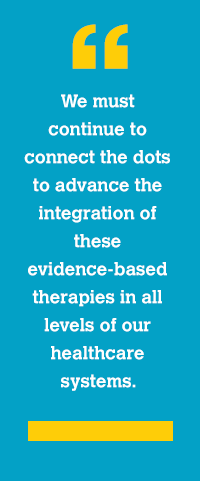 In the second session, we heard first from Maggie Buckley, MBA, BCPA, representing both The Pain Community and The Ehlers-Danlos Society, who shared her experience as a Board Certified Patient Advocate with real-world patient examples from the perspective of people with pain – in particular the opportunities and challenges accessing care via telehealth and telemedicine during COVID. She also recounted her own recent visit to the ER for an acute painful episode during the pandemic –which illuminated the paradoxical challenges of accessing the right care at the right time for chronic pain. Case in point is that Maggie knew from her own experience living with Ehlers-Danlos that acupuncture would help this acute episode, and the ER physician, with experience in military battlefield acupuncture, agreed. Despite their shared agreement, there was no access to an acupuncturist and an opioid prescription was provided (but not taken).
In the second session, we heard first from Maggie Buckley, MBA, BCPA, representing both The Pain Community and The Ehlers-Danlos Society, who shared her experience as a Board Certified Patient Advocate with real-world patient examples from the perspective of people with pain – in particular the opportunities and challenges accessing care via telehealth and telemedicine during COVID. She also recounted her own recent visit to the ER for an acute painful episode during the pandemic –which illuminated the paradoxical challenges of accessing the right care at the right time for chronic pain. Case in point is that Maggie knew from her own experience living with Ehlers-Danlos that acupuncture would help this acute episode, and the ER physician, with experience in military battlefield acupuncture, agreed. Despite their shared agreement, there was no access to an acupuncturist and an opioid prescription was provided (but not taken).
(Editor’s note: relevant to Maggie’s story above, congratulations to Dr. Jeff Dusek and colleagues at University Hospitals Connor Integrative Health Network To Study Acupuncture In The ED With $2+ Million Grant)
Next, we heard from Joanna Katzman, MD, MSPH, Director of University of New Mexico Pain Center and Medical Director of the Pain, Substance and Public Health Program at Project ECHO. ECHO is a telementary (or telementoring) forum (now in 50 states and 40 countries worldwide) in which clinicians teach other clinicians in a mixture of didactics and real-world, case-based learning. It is particularly adaptable and designed for use for specialists to teach primary care providers in rural and underserved communities.
Potential benefits are big and show up in quality and safety taught by evidence-based guidelines (reducing variation in care), rapid dissemination of best practices, cost effective care and increased access to care for rural and underserved patients while challenges are considerable in clinician time, broadband infrastructure and leadership buy-in.
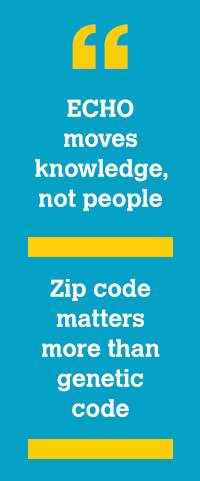 Then Sharad Kohli, MD, family physician at People’s Community Clinic (PCC), an FQHC in Austin, Texas, spoke about their integrated care for underserved people. He underscored their experiences innovating, seeking relevant funding, and building key partnerships that have increased access to integrative therapies that would otherwise simply be unavailable.
Then Sharad Kohli, MD, family physician at People’s Community Clinic (PCC), an FQHC in Austin, Texas, spoke about their integrated care for underserved people. He underscored their experiences innovating, seeking relevant funding, and building key partnerships that have increased access to integrative therapies that would otherwise simply be unavailable.
The PCC’s self-designed program addresses trauma and pain within its patient population in multi-varied ways, and from the primary perspective of prevention, including access to behavioral treatment, substance abuse programs, exercise, acupuncture, nutrition and yoga therapy. Massage therapy will be added post-COVID. Dr Kohli and his team address downstream as well as upstream social determinants of health and social needs through the program and provide important structural support to their patients via the People’s Medical-Legal Partnership Clinic.
Dr. Shari Ling, MD, Deputy Chief Medical Officer, Centers for Medicare and Medicaid Services spoke to key CMS policies in the face of emerging information about the increasing complexity of the Medicare and Medicaid population.
Dr. Ling referred to the recent decision of Medicare Coverage for Acupuncture for Chronic Low back pain (cLBP) provision based on a review of available evidence and for which the supervision of a physician needs to be in place because it is the individual who will be billing Medicare. She noted that the use of acupuncture for other conditions beyond cLBP could be considered if the evidence is there.
Since the decision to cover acupuncture for cLBP was just made in January 2020, with the intersectionality of COVID-19, there have been delays that are impacting the how quickly we will see outcomes from these fee-for-service claims. CMS is implementing Section 6032 and the Todd Graham provision, and this be another channel in which CMS will review evidence in support of both broadly applicable treatments and services for pain as well as others very specific to a certain population.
Following Dr. Ling, the second interactive panel took a deeper dive into the area of acupuncture and was moderated by Ariana Thompson-Lastad, PhD, Chair, Integrative Medicine for the Underserved. In addition to Drs. Ling and Kohli, this panel included David Miller, MD, LAc, Immediate Past Chair, American Society of Acupuncturists and Mary Faria, PhD, FACHE, President & CEO, AOMA Graduate School of Integrative Medicine, who were able to ask and share real-time issues and successes from their vantages. For example, Mary Faria and Sharad Kohli discussed an innovative 17-year relationship between The People’s Community Clinic in Austin, TX, and local acupuncture school, AOMA, which has allowed for increased access to acupuncture for people who are underserved.
Rounding out the afternoon presentations, Samantha Simmons MPH, President of the Oregon Collaborative for Integrative Medicine shared details about the ramp up of the Whole Health in The States initiative, a ground breaking pilot program primarily funded by the Lovell Foundation, to expand access to and drive utilization of comprehensive pain care in Medicaid in Arizona, Washington, Oregon, California, Vermont, Illinois and Washington, DC.
Trackbacks/Pingbacks